- Author: Kathy Keatley Garvey
What insects did you see during the Solar Eclipse, dubbed "The Great North American Eclipse?" And what were they doing?
In some parts of North America, as the moon passed between the earth and sun, folks saw a total solar eclipse. But here in Solano County, California, totality it was not.
Partial.
We watched the Great North America Eclipse as the moon took a tiny bite out of the sun.
And then a queen bumble bee buzzed into our pollinator garden just as the moon helped itself to another bite.
Bite of the moon or bite of the bumble bee?
Game over.
The bumble bee won (well, just for a few minutes) and then we returned to the solar eclipse.
The bumble bee appeared to be a Bombus californicus. And she was hungry.
If she had experienced a total solar eclipse, she may have immediately returned to her nest: "It's dark. Day over."
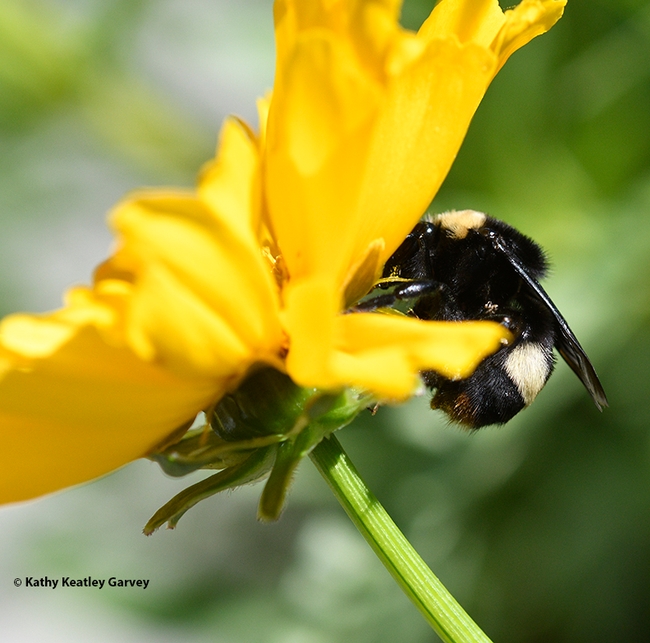
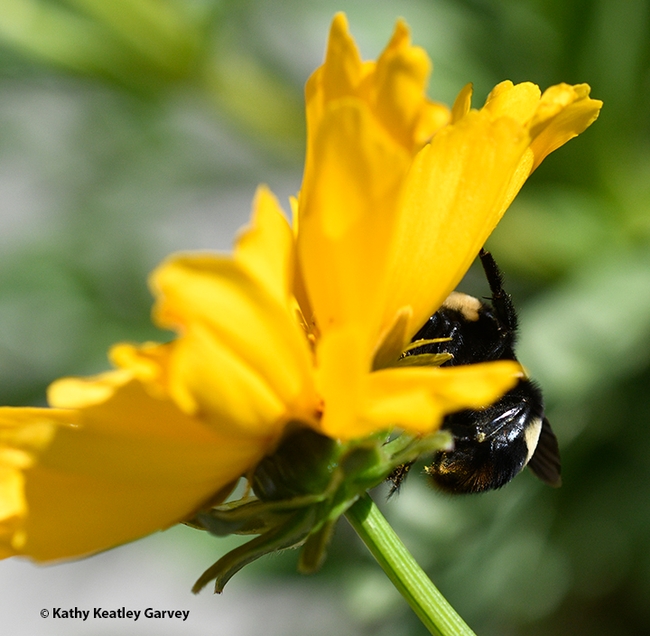
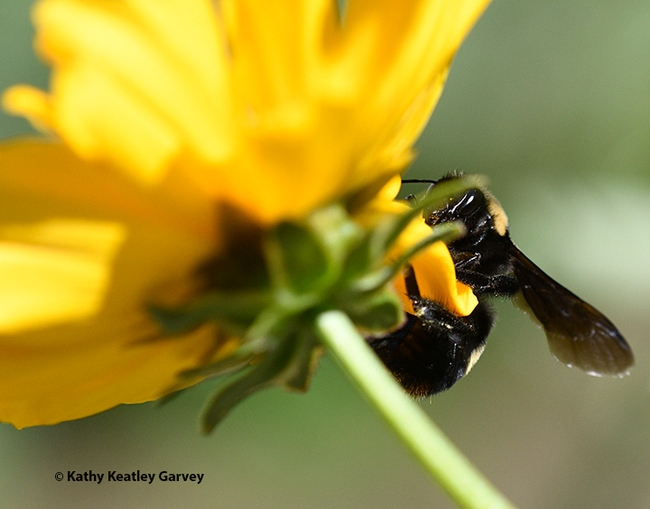
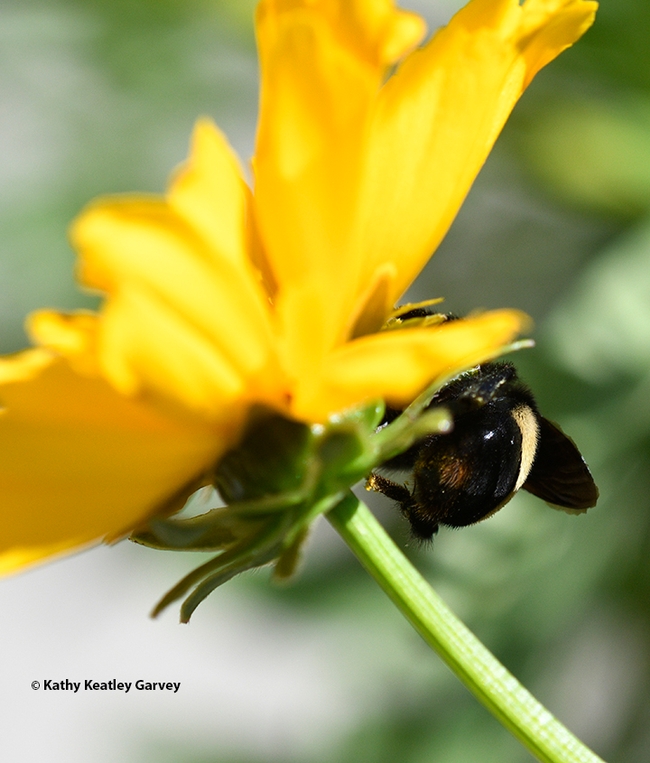
- Author: Kathy Keatley Garvey
A perfect match: a bumble bee foraging on a Mexican sunflower, Tithonia rotundifola.
Lately we've been observing a bumble bee, identified as a maleCalifornia bumble bee, Bombus californicus, sipping nectar from the colorful orange blooms in our Vacaville pollinator garden.
B. californicus is one of 27 bumble species recorded in California, according to the four University of California authors of California Bees and Blooms: A Guide for Gardeners and Naturalists, published in 2014 by Heyday. Gordon Frankie, Robbin Thorp, Barbara Ertter and Rollin Coville co-authored the book. Thorp (1933-2019), distinguished emeritus professor, UC Davis Department of Entomology and Nematology, also co-authored Bumble Bees of North America: An Identification Guide, published in 2014 by the Princeton University Press.
Worldwide, there are 250 species in the genus Bombus. The most common bumbles we see are the yellow-faced bumble bee, B. vosnesenkii; the black-tailed bumble bee, B. melanopygus; and the California bumble bee (no yellow hairs on its face).
In California, bumble bees "are most common and diverse in the North Coast and Sierra-Cascade ranges," the authors wrote. They identified a total of 10 in urban gardens, but only three (the ones we see) are common.
"The ability of bumble bees to buzz-pollinate certain high-value crops, such as greenhouse tomatoes, has led to recent introductions from Europe to many areas of the world where they previously did not exist, especially B. terrestris, the Large Earth Bumble Bee."
If you spot a bumble bee in California, the California Bumble Bee Atlas wants to know. "Launched in 2022, the California Bumble Bee Atlas is a collaborative community science effort to track and conserve the state's native bumble bee species," according to its website. ? The group is hosting a Bumble Bee Atlas Survey Bio Blitz July 28-30. Check out the Facebook page.
You can also load your images on iNaturalist.
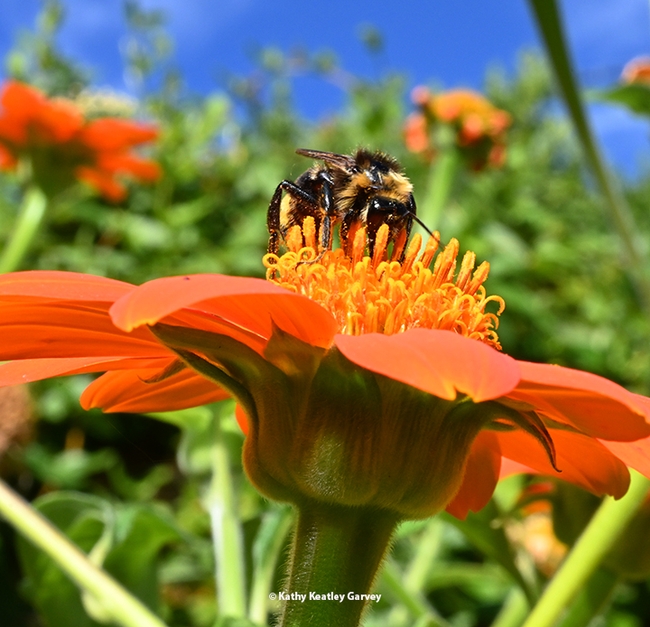
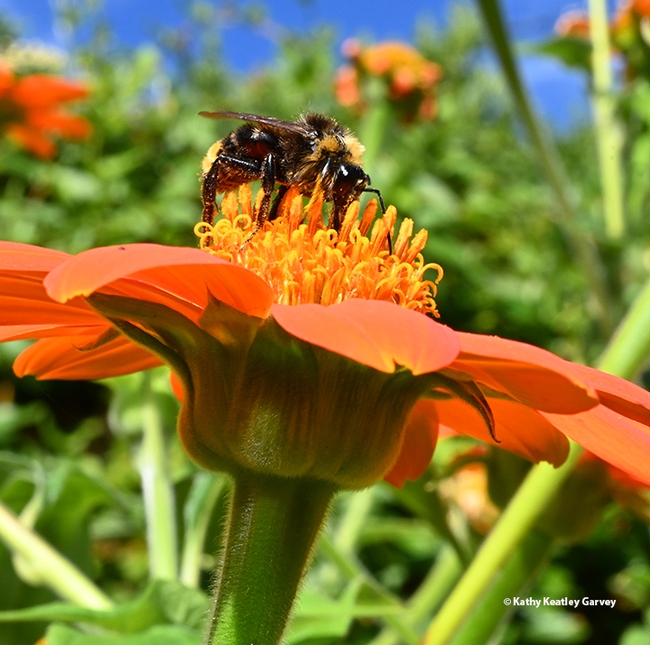
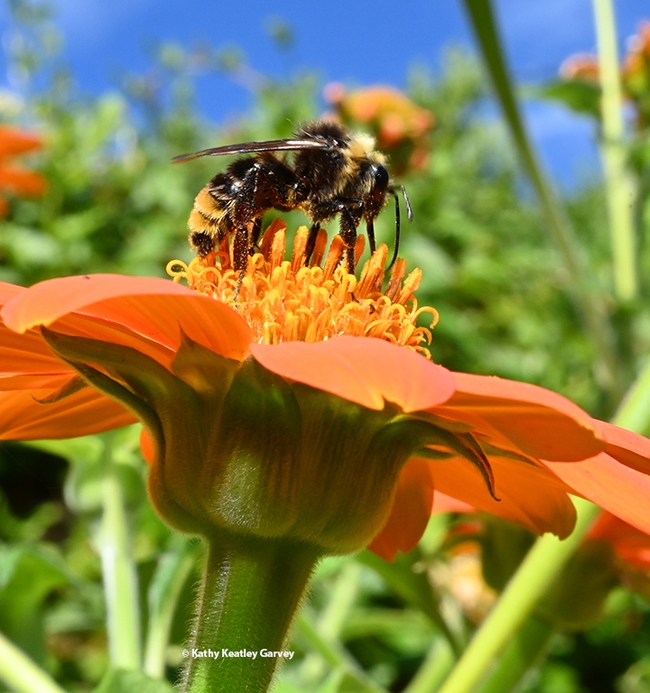
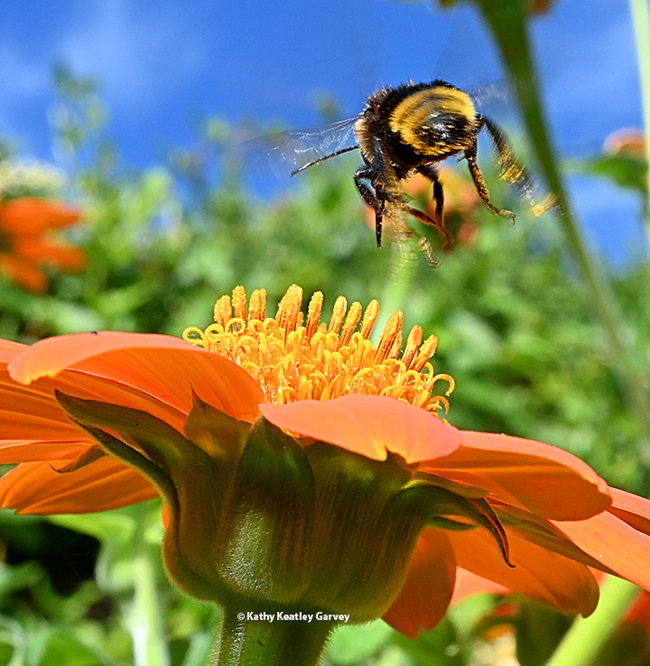
- Author: Kathy Keatley Garvey
We just met a male black-faced bumble bee, Bombus californicus.
It was early morning and he was resting on a blanket flower (Gaillardia), a brilliant member of the sunflower family. When you're a bee, a blanket flower offers both bed and breakfast.
Gaillardia was named after M. Gaillard de Charentonneau, an 18th-century French magistrate who was a patron of botany, according to Wikipedia. "The common name may refer to the resemblance of the inflorescence to the brightly patterned blankets made by Native Americans."
The bumble bee species, a native, takes its name from California. Unlike the yellow-faced bumble bee, Bombus vosnesenskii, its face is black and long. (Except when it's covered with golden pollen.)
Authors Kate Frey and Gretchen LeBuhn in their newly published book, The Bee Friendly Garden, note that unlike honey bees, bumble bees can fly in "cold rainy weather...They have several physiological adaptations that allow them to fly in bad weather, including the ability to shiver to raise their body temperature."
Frey, a world-class garden designer and LeBuhn, a bee expert and professor at San Francisco State University, offer advice on how to attract bumble bees and other pollinators to your garden. They quote native pollinator specialist Robbin Thorp, distinguished emeritus professor of entomology at the University of California, Davis, and the co-author of Bumble Bees of North America: And Identification Guide and California Bees and Blooms: A Guide for Gardeners.
What we know is this: it's good to have bed and breakfast for a bumble bee. Much of the bumble bee population is declining and we all need to do what we can to protect them and provide for them.
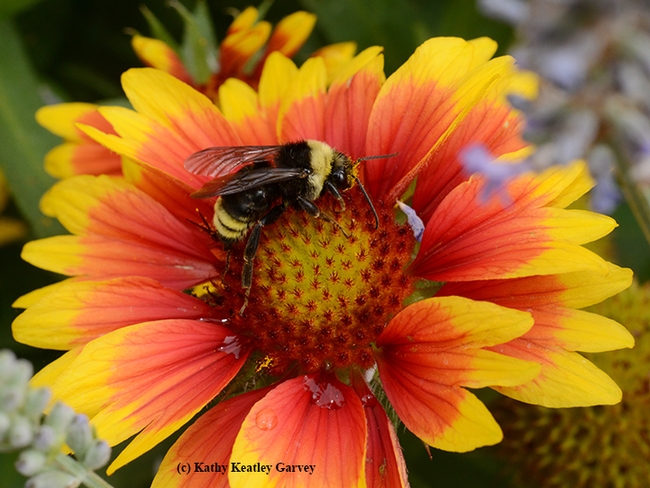
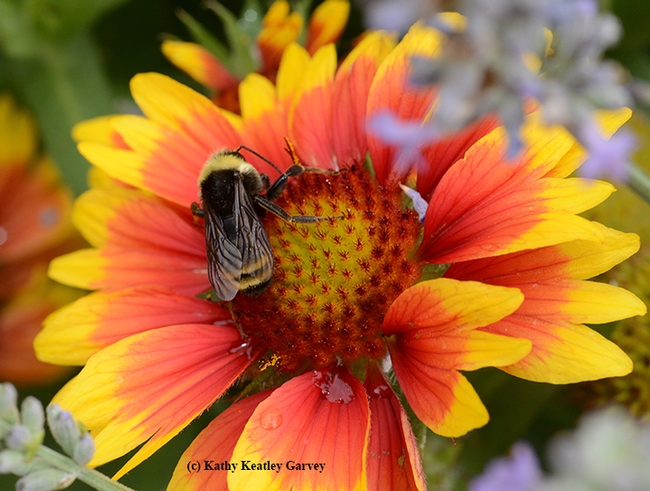
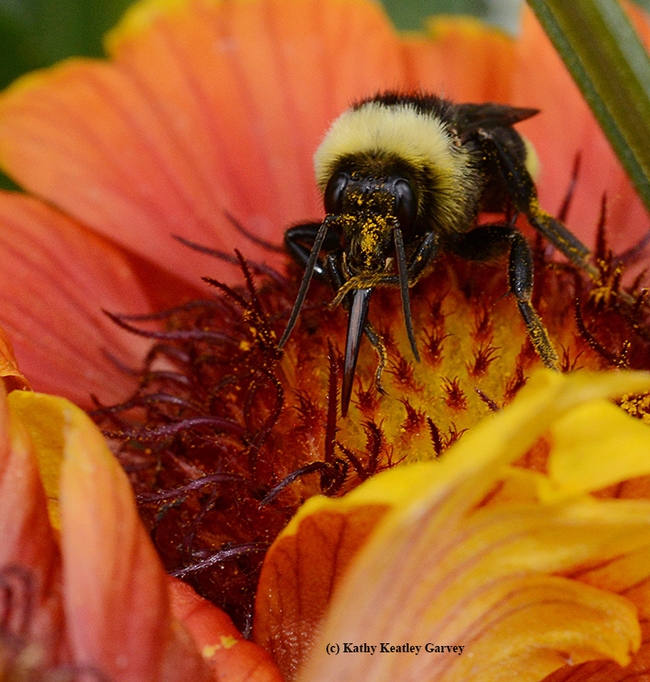
- Author: Kathy Keatley Garvey
Possession is nine-tenths of the law.
It also applies to bees foraging on lavender.
A black-faced bumble bee (Bombus californicus) this morning stretched between two lavender stems and lingered there--probably to warm its wings for flight. Along comes a honey bee (Apis mellifera) interested only in foraging for nectar.
The bumble bee holds its ground--or the stems.
The honey bee glances over at the yoga pose, sips some nectar, and buzzes off--this time probably hoping for an unoccupied blossom.
So, what does "possession is nine-tenths of the law" really mean?
Says Wikipedia: "Although the principle is an oversimplification, it can be restated as: 'In a property dispute (whether real or personal), in the absence of clear and compelling testimony or documentation to the contrary, the person in actual, custodial possession of the property is presumed to be the rightful owner."
When we left the lavender patch, the bumble bee was still in possession. But they did share. Momentarily.


- Author: Kathy Keatley Garvey
It's a delight to see boy bumble bees sleeping overnight in the lavender.
Two species of bumble bees--Bombus vosnesenkii and Bombus californicus--have been slumbering in our lavender for the past several weeks. Sometimes they nestle a half inchs from one another and other times they're a foot or more apart.
Usually the honey bees began foraging in the lavender before they do.
The yellow-faced bumble bee, Bombus vosnesenskii, and the black-faced bumble bee, Bombus californicus, are two of the bees featured in Bumble Bees of North America: an Identification Guide, published by the Princeton University Press and authored by Paul Williams, Robbin Thorp, Leif Richardson and Sheila Colla.
Thorp, a native pollinator specialist and distinguished professor of entomology at the University of California, Davis. says there are 20,000 species of bees worldwide, and of that number, only 250 belong to the genus Bombus or bumble bees.
Several species of bumble bees in our bee garden seem to prefer the English lavender. They forage, they mate, and they sleep.
The females sleep in their underground nests at night, while the males sleep on the lavender stems.
They are a joy to have around--underground and above ground!




